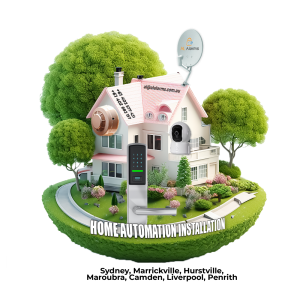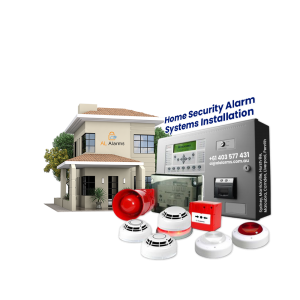In today’s world, safety and security are of paramount importance for both homes and businesses. With the advent of CCTV cameras, home and office surveillance has reached new heights, allowing you to monitor your property from anywhere in the world.
Setting up a surveillance system in your desired location, whether at home or in the office, has never been easier.
This blog will focus on home networking in Sydney, Marrickville, Hurstville, Maroubra, Camden, Liverpool, and Penrith, exploring options like DVR and NVR systems to help you make an informed decision.
The Importance of Home Networking in Surveillance :-
Home networking plays a crucial role in modern surveillance systems. It connects various devices, such as cameras, recorders, and monitors, enabling seamless communication and data transfer. A well-designed home network ensures that your surveillance system operates efficiently.
They provide real-time monitoring and recording capabilities. With advancements in technology, home networking has become more accessible and user-friendly. Technologies make it easier for homeowners to set up and manage their surveillance systems.
DVR vs. NVR | Understanding the Systems and Their Functioning :
The fundamental contrast between a Digital Video Recorder (DVR) and a Network Video Recorder (NVR) is in how they handle raw video data. Knowing these distinctions can assist you in selecting the appropriate system for your requirements.
[1] Digital Video Recorder or DVR Systems or Its Constituent Parts :-
(i) Analog Cameras :
DVR systems commonly utilize analogue security cameras, also referred to as CCTV cameras. These cameras send analogue signals to the recorder, which then processes the video data.
DVR security systems are generally priced lower than NVR systems due to the simpler and more economical nature of analogue cameras.
(ii) Coaxial Cables :
Analogue cameras connect to the DVR via a coaxial cable, which can extend up to 500 meters but may have certain limitations.
Unlike Power over Ethernet (PoE) cables, coaxial cables do not provide power to the camera, necessitating the use of two types of cables—one for power and one for video transmission.
Coaxial cables are thicker and less flexible than Ethernet cables, making installation more difficult. Furthermore, standard coaxial cables do not support audio transmission, requiring an additional RCA connection for audio support.
(iii) AD Encoder :
DVR recorders depend on AD encoders to process raw video data from the camera into viewable footage.
As a result, each camera in a DVR system must be connected to the recorder and a separate power source.
(iv) Audio Limitations :
Regular coaxial cables do not transmit audio signals by default, which necessitates an additional RCA connection to support it.
DVR recorders also have a fixed number of audio input ports, restricting the number of cameras that can record sound.
(v) Here are the features of DVRs :
(a) DVRs are easy to install and operate because they do not require any drivers to be installed.
(b) They offer high frames per second recording at a lower price.
(c) These systems are reliable and cannot be hacked, as they use a more stable Linux operating system.
(d) You can check the video footage by connecting to a TV output.
(e) DVRs are smaller, do not make noise, and are easier to conceal.
(f) They do not require frequent updates and take up much less storage space.
(g) DVRs consume less power.
If you find this surveillance system is appropriate for your home networking in Blacktown, Burwood, Picnic Point, Homebush, Castle Hill, Mona Vale, and Bankstown to ensure safety and security you can install the system with the help of professionals.
[2] Network Video Recorder or NVR Systems and its Constituent Parts :-
(i) IP Cameras :
NVR systems utilise IP cameras, which are capable of processing video data before relaying it to the recorder.
IP cameras are typically more robust and can record and transmit audio in addition to images. Advanced hardware on IP cameras allows for intelligent video analytics like license plate and facial recognition.
(ii) Ethernet Cables :
If not wireless, IP cameras typically connect to the recorder via Ethernet cables, which can run up to 100 meters.
Ethernet cables have several advantages over coaxial cables, including the ability to transmit power, video, and audio through a single cable if PoE-capable. This eliminates the need for splitters commonly seen in DVR systems. However, not all Ethernet-connected cameras are PoE-capable, and many still require a separate power supply.
(iii) Recorder :
The NVR recorder is used only for storing and viewing footage, as video data is processed at the camera before being sent to the recorder.
(iv) Audio Support :
Ethernet cables can transmit audio natively, allowing cameras with microphones on an NVR system to record audio to the NVR.
(v) Higher Storage Capacity :
NVR camera systems can upload footage to cloud-based servers, an advantage of being connected to the internet. Unlike DVR systems, they aren’t limited to on-premise storage, supporting a higher capacity.
Here are the features of NVR :
(a) The system is easy to install with a simple user interface.
(b) It can connect to multiple servers and multiple cameras.
(c) You can get remote access to live footage using a PC or Smartphone.
(d) You can easily export video files.
(e) When you need any particular video you can video file easily by searching by time, date, camera, or events.
(f) The system comes with an alarm-based camera recording feature available.
Factors to Consider When You Choose NVR and DVR :-
Both Digital Video Recorder (DVR) and Network Video Recorder (NVR) systems store video footage on a hard drive, but their variances are in design and execution. The most suitable system for you relies on your specific requirements.
Here are some factors to consider :
(i) Existing Hardware :
What kind of wiring is currently in place? Are you willing to upgrade it ?
(ii) Technical Proficiency :
Are you at ease with configuring network devices ?
(iii) Maintenance :
How much upkeep is necessary ?
(iv) Accessibility Requirements :
Who needs to have access? Is remote access a necessity ?
These questions are necessary to answer when you decide on any of them while establishing home networking in Sutherland, St Marys, Campsie, Parramatta, Quakers Hill, Strathfield, and Pennant Hills for your home.
Conclusion :-
Home networking and surveillance systems have evolved significantly, providing various options to ensure safety and security. Whether you choose a DVR or NVR system, understanding their components, pros, and cons will help you make an informed decision that best suits your needs. With the right setup, you can monitor your property effectively, ensuring peace of mind.
At Al Alarms, we offer a comprehensive range of Network Video Recorders and Digital Video Recorders. We assure you that we provide high-quality recorders ensuring high-resolution images to make your home security top-notch and impenetrable for any kind of mischief.
To ensure home networking in West Mead, Lidcombe, Picton, Kings Wood, Kings Grove, Marrickville, and Botany, you can trust us. You can monitor your home and property from afar using a computer, Smartphone or tablet.
Do not waste your time by looking here and there! Contact us today and let us install IP Cameras, CCTV systems, NVR and DVR systems for your home security as we are confident to provide you with robust home networking.




